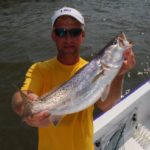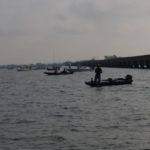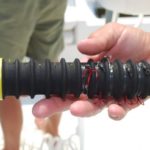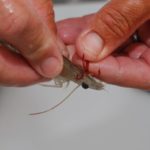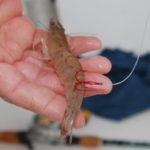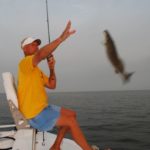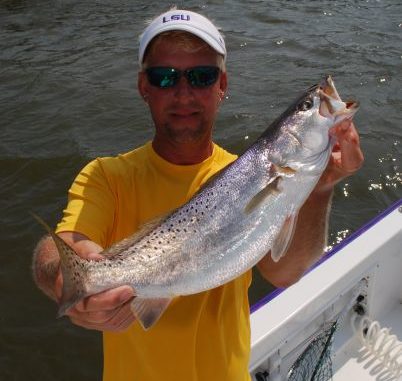
Follow this guide’s strategy to put Lake Pontratrain trout – and drum – on the grill.
Let’s see: You are a charter guide and your clients just cancelled at the last minute because of an emergency.
The wife and daughter are out of town for the weekend. You have your nearly 17-year-old son still kicking around the house, though.
So what do you do?
Take a break from the 180 days that you spend on the water chasing speckled trout and go to a movie? Sleep late?
Nah!
You and your son decide that you want to eat grilled speckled trout and black drum; you grab the kid and head out before daylight.
A busman’s holiday. Definition: A vacation from work in which one engages in doing exactly the same activity as one does at work.
Some people just love to fish. Greg Schlumbrecht, charter fishing guide and speckled trout maniac from Slidell, is one of those. And he seems to be rearing another fanatic, his son Gregory.
Daylight is cracking as the younger man dropped the boat’s anchor down-current of the Tressels, the local name for the railroad bridge that spans the eastern end of Lake Pontchartrain and paralleling the Highway 11 Bridge.
Anglers were positioning boats on both sides of him, while others were cruising up and down near the bridge looking for a spots that appealed to them.
It’s the dog days of summer in Lake Pontchartrain — not Schlumbrecht’s favorite time to fish for speckled trout.
In spring and fall, the lake’s beasts devour artificial lures, but in the heat of the summer they get picky and only live bait of some sort works consistently.
Schlumbrecht, owner of To Fish Charters, has his bait well full of live shrimp.
His curly-haired, handsome young son is wired up.
“I get to fish with dad 10 to 12 times a year,” the younger Schlumbrecht said. “He is always busy fishing, but I understand. I love to fish with him.”
His enthusiasm was infectious. Earlier in the morning the agile youth was bouncing in and out of the boat, loading it with live shrimp and gear, then prepping the fishing rods. His slightly slower-moving 44-year old father has him well-trained.
“I started fishing at age 3,” young Gregory explained.
Schlumbrecht returns to the spot on the bridge where he did well yesterday. On the Tressels, that’s easy: Each set of pilings, called “poles” by the locals, is marked by a spray-painted number over it.
But things had changed overnight.
When it gets light enough to see well, the elder Schlumbrecht noted that the water had become discolored rather than clear green. Tidal water movement is often stronger on one end of the bridge than the other, so the water can be fish-green on one end and muddy on the other.
The two weighed anchor and chugged a short distance farther along the bridge till the water turned green. They pulled to within casting distance of the bridge and drop anchor again.
They began catching fish immediately, not the “spotted sea monsters” as the elder Schlumbrecht calls the big ones he so loves for his clients to catch, but good eating-sized fish, under two pounds. Just what they were looking for.
Their Carolina rigs were simple, a 3/8-ounce egg sinker set above a barrel swivel, to which a 30-pound test fluorocarbon leader was tied. Either a No. 4 or No. 6 treble hook was used.
“I want to use the biggest hook that I can get away with,” Greg explained, “but I don’t want the big hook to affect the shrimp.”
He is almost fanatical about the use of fluorocarbon for leader material, but the length isn’t important to him.
“A foot-and-half to 2 ½ feet, whatever I feel like,”
he said.
This will be the same rig they use all day, at every bridge where they soak their live shrimp. The only variation will be in the size of the sinker: In the strongest current, they will use up to 2 ounces of weight.
Greg’s dictum for fishing the lake is the same, whether fishing with plastic Deadly Dudleys on jig heads or live bait — Stay on the bottom!
The farthest he gets off the bottom is when he uses a sliding cork with live bait. Then he will set the stopper for the cork so the bait is 6 to 12 inches off the bottom. He uses a nifty little contraption to set the proper depth quickly: a couple of weights on an 8-inch loop of line.
He puts a sliding cork on his line, followed by a leader and hook. Then he loops the loop over his hook and lowers it to the bottom. When it hits bottom, he puts the stopper on the line a few inches below where the line enters the water. The cork will then suspend the live bait the preferred distance off the bottom.
The 10-year veteran guide spools his casting reels with 17-pound-test fluorocarbon line, but admits that monofilament will also work. But he doesn’t like braided line.
“The lake is usually clear enough that braid will kind of glow in the water,” he said.
The bite was steady, and young Gregory showed that he is almost as deft as his dad. But the duo soon became bored with the ho-hum-sized fish. Besides, they needed some drum for the grill.
Next stop was the Rigolets Bridge, where Highway 90 crosses the Rigolets Pass. The beautiful high-rise concrete span is hardly recognizable to those used to the old rickety wreck.
Gregory dropped the anchor in 22 feet of water, and the boat swung to a stop. His dad sensed a teaching moment.
“Nothing is more aggravating than having an anchor that won’t grab,” Schlumbrecht said. “The key to anchoring in Lake Pontchartrain is to use lots of chain.
“Most Danforth anchors have 6 feet of chain. I have 12 feet, and I use one size heavier chain than they usually put on them.”
Good anchor bite or not, in 20 minutes the men decided that they were killing bait shrimp in vain. They headed off down the Rigolets to the L&N (CSX) Train Bridge over the pass, nearer to Lake Borgne.
They anchored the boat behind and within casting distance of the big wooden bumpers on the east side of the draw.
Neither this bridge nor the Rigolets Bridge had another boat on it, a welcome relief from the Tressels where it felt like we had a neighboring boat under each armpit.
The deep water and heavy currents here forced the men to step up to 2-ounce sinkers on their Carolina rigs.
Even in the strong current, they put their shrimp on the hook by impaling one hook of the treble through the thick part of the horn on top of the heads of the shrimp. Ocasionally, Schlumbrecht said, when trout seem to be persistently knocking the shrimp of the hooks without getting hooked he will hook them through second section of the body above the tail.
But they didn’t have to resort to trickery here. They started putting a mixed bag of redfish and respectable-sized trout in the boat.
Then Gregory sinks the hook home into what behaved like Capt. Nemo’s submarine.
It was a slugfest — nothing glamorous, just brutal.
Dad didn’t help things with his constant, but good-natured banter to the young man about his inability to quickly subdue the fish. When a broad, gray back broke the surface, the men’s suspicions were confirmed: It was a turbo-sized black drum, fully one-fourth the weight of its captor.
It was too big for the grill, so for the second time in the morning they left fish biting to go hunt for a black drum.
Greg had confidence that anchoring under the I-10 bridge near the Orleans Parish side would produce his drum.
“We catch them every time we stop there,” he said.
And so it is. The two men quickly boated several perfect-sized puppy drum and two sheepshead. The sun had gotten hot. They had their supper, plus lots of fish for a friend.
Bacheloring … it ain’t half-bad.
Editor’s Note: Capt. Greg Schlumbrecht (985-960-1709) is featured angler in the soon-to-be-released book “Trout Masters Too: How the Pros Do It,” a guide to how some of Louisiana’s best professional fishermen catch trout at Louisiana’s top fishing destinations.
